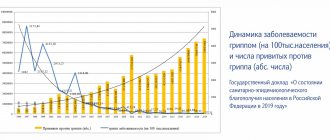The vaccine is intended for routine prevention of rubella.
Production - Russia.
Cultured live attenuated rubella vaccine, lyophilisate for preparing a solution for subcutaneous administration, made from “Live attenuated rubella vaccine, substance - frozen solution” (strain RA 27/3) produced by the Institute of Immunology, Inc., Republic of Croatia, ( "INSTITUTOF IMMUNOLOGY, INC", CROATIA), registered in the Russian Federation.
Vaccine options
The live attenuated rubella vaccine has been used for more than 40 years. A single dose provides over 95% of long-term immunity, similar to immunity developed as a result of natural infection. Rubella vaccines are either monovalent (a vaccine that targets only one pathogen) or, most often, combined with other vaccines, such as measles (MR), measles and mumps (MMR) or measles, mumps and varicella vaccines. (KSKV). In Russia the following are used: live rubella vaccine, live attenuated rubella vaccine, Priorix, MMR-II.
Possible side effects
Vaccination against rubella in children is easily tolerated without complications if the correct procedure is followed. However, within 6-12 days after vaccination, an increase in temperature to 39.5 degrees may be observed. There is no need to worry if this condition lasts no more than two days. High fever may also be accompanied by chills and muscle pain.
Vaccination may cause rashes. But this is a fairly common reaction of the child’s body to vaccination. The rash appears as red spots that cover the face, body and limbs. They do not pose any health hazard and disappear on their own without a trace.
Although most often the vaccination takes place without any side complications, they are still possible in the form of the following symptoms:
- Enlarged lymph nodes.
- The appearance of a lump at the injection site. Redness and swelling may also occur. Such manifestations may last a couple of weeks, this is not a cause for concern.
- If boys are vaccinated with a combined vaccine (the so-called three-component vaccine against three infections), the boy’s testicles may be painful and swollen. This also does not entail any serious consequences.
- Reactions such as cough, runny nose, redness of the throat and other short-term symptoms are also considered normal.
An adult body tolerates vaccination much more difficult.
Principles and purposes of vaccination
If a woman is infected with the rubella virus early in her pregnancy, she has a 90% chance of transmitting the virus to her fetus. This can lead to miscarriage, stillbirth, or severe birth defects known as CRS. Therefore, prevention of this disease is extremely important. By the end of 2013, rubella vaccine had been introduced nationally in 137 countries.
There are three main approaches to eradicating rubella and CRS: vaccinating children, vaccinating adolescent girls, and vaccinating women of childbearing age who plan to have children. The first strategy is effective against rubella itself, but does not completely solve the problem of CRS (this will require 20-30 years), since, according to available data, vaccination protects for about 20 years, which means that, theoretically, it can shift the incidence of rubella to childbearing years age. The second strategy, vaccinating teenage girls, is effective in eradicating CRS (although it will take 10-20 years to achieve this goal), but does not solve the problem of rubella incidence in general (in Russia, the peak occurs at the age of 7-14 years). Vaccination of women is extremely effective in combating CRS (although achieving 100% coverage of the adult population is almost impossible), but also does not solve the problem of rubella itself.
In view of these considerations, WHO recommends a combination of all three strategies whenever possible. An example of such a combination is the United States, where, in addition to vaccinating children, vaccination is carried out in colleges and the Armed Forces. In accordance with the National Vaccination Calendar, children from 1 to 18 years of age, women from 18 to 25 years of age (inclusive), who have not been sick, not vaccinated, vaccinated once against rubella, and who do not have information about vaccinations against rubella, must be vaccinated. An interesting solution to the problem of vaccinating women of childbearing age was found in France - a refusal to register a marriage in the absence of a stamp of vaccination against rubella or a record of previous infection.
Does a child need vaccinations?
Although rubella is not a fatal disease, there are factors that confirm the need to vaccinate your child. These include:
- If a child is not vaccinated before the age of six, there is a chance that he may develop progressive rubella panencephalitis. The outcome of this disease is fatal.
- In the case of a three-component vaccine, the child will receive protection not only from rubella, but also from measles and mumps, and therefore will not become infected with them, and will not suffer possible complications from diseases.
- Rubella causes serious complications if infected in adulthood. In order to prevent this, it is better to get vaccinated in childhood.
Contraindications
Immunodeficiency conditions; malignant blood diseases and neoplasms. severe reaction (temperature rise above 40 C, swelling, hyperemia more than 8 cm in diameter at the site of vaccine administration) or a complication to the previous dose; acute infectious and non-infectious diseases, exacerbation of chronic diseases - vaccination should be carried out no earlier than 1 month after recovery; pregnancy;
Notes:
- When prescribing immunosuppressants and radiation therapy, vaccination is carried out no earlier than 12 months after the end of treatment;
- HIV - infected children can be immunized with rubella vaccine;
- The vaccine should not be administered during pregnancy. Precautions must be taken to avoid conception for 2 months after vaccination.
Rules
For vaccination to be effective, you need to adhere to certain rules and vaccination techniques:
- Vaccination must be administered by a qualified nurse;
- Before the procedure, the child must be examined by a pediatrician. If it does not reveal any contraindications, the child is allowed to undergo vaccination after drawing up an examination protocol;
- the procedure is carried out using a sterile syringe with a special needle suitable for subcutaneous injections;
- According to the instructions, the ampoule with the vaccine should be opened only before starting the injection. It is contraindicated to draw the drug into a syringe in advance;
- treat the ampoule with an antiseptic solution before opening;
- Before the vaccine is administered, the skin is treated with an antiseptic; after administration, the injection site is also treated;
- The vaccine is given subcutaneously or intramuscularly. One-year-old children are vaccinated in the thigh, and starting from the age of six - in the shoulder or under the shoulder blade;
- the injection is not administered into the buttocks, because there is a lot of subcutaneous tissue there, and this can lead to the formation of compactions, which will reduce the effectiveness of immunization.
According to the plan and scheme of the National Vaccination Calendar, the vaccine must be given twice. Since after the first immunization the body does not yet provide complete protection against infection.
Why are measles, rubella and mumps dangerous?
First of all, the fact that an infected person can act as a source of spread of a viral infection and at the same time not know about the presence of the disease. The incubation period for measles, rubella and mumps lasts from 10 to 20 days. Symptoms of the disease appear after this time and persist for 1–2 weeks.
For 1 week after their disappearance, the person still continues to be a spreader of the virus.
Measles, against which children are vaccinated as part of the CCP, is considered one of the most contagious. The disease is transmitted through contact with a sick person in 95% of cases. Particularly severe variants of the course of the disease are accompanied by the development of encephalitis, hepatitis, and pneumonia in young patients. There are cases of death. Infection with this disease can occur both in utero and by airborne transmission. In the early stages of pregnancy, there is a risk of fetal death, development of dementia or mental retardation. In the later stages, there is a possibility of premature birth.
Mumps in 15% of cases of disease development leads to damage to the membranes of the brain and spinal cord. According to statistics, every 20,000 sick person experiences deafness (after suffering from labyrinthitis). In boys and men, this disease causes inflammation of the testicles and appendages. Representatives of the adult population have prostatitis. Occasionally, mumps is accompanied by the occurrence of complications in patients such as pancreatitis, nephritis, mastitis, etc.
Rubella detected in women in the first trimester of pregnancy is a medical indication for its termination. If this is not done, in 80% of cases the newborn will be diagnosed with heart defects, mental retardation, deafness or cataracts. A child is born with congenital rubella. For 6–30 months, he undergoes treatment, acting as a source of infection and infection of all people in his circle of contacts.
Interaction with other drugs
Vaccination against rubella can be carried out simultaneously (on the same day) with other calendar vaccinations (against whooping cough, diphtheria, tetanus, mumps, measles, polio, hepatitis B) or no earlier than 1 month after the previous vaccination. When simultaneous vaccination, drugs are administered to different places; mixing vaccines in one syringe is prohibited.
Immunoglobulins and blood products:
After administration of blood products (immunoglobulin, plasma, etc.), the vaccine is recommended to be administered no earlier than 3 months later. After administration of the rubella vaccine, blood products can be administered no earlier than 2 weeks later; If it is necessary to use immunoglobulin earlier than this period, vaccination against rubella should be repeated after 3 months. If there are antibodies to the rubella virus in the blood serum, repeated vaccination is not carried out.
| Name of service | Price |
| Rubella vaccine (prevention of rubella) | 46 rub. |
Vaccination against rubella
German measles, known for many centuries, suddenly came into the spotlight in the middle of the last century. In 1965, the epidemic broke out throughout Europe, reaching the United States by 1964. Millions of people have been ill, including adults, with subsequent complications. The consequences of this pandemic have attracted the attention of scientists to the problem of rubella infection. In America alone, in two years, 20 thousand babies were born with congenital deformities caused by maternal illness. By 1965, it became clear that vaccination against rubella was the primary task of scientists.
In the same year, doctors managed to obtain several weakened strains of rubella virus in the laboratory. The clinical trial lasted almost three years and by 1970 the vaccine finally went into commercial use. In 1971, a vaccine based on a strain isolated from human cells was licensed in Europe. It is designated RA 27/3 and is still in use today. Over time, it was licensed in the United States and several other countries. The mass immunization scheme in Europe, the UK and the States has shown a gradual decline in CRS cases and the disease in general. In 2015, the Region of the Americas was declared completely free of endemic rubella.
Today, out of 194 countries, 152 states have adopted a rubella vaccination plan. However, within each country the percentage of diseases varies, as do the cases of CRS. The WHO Strategic Advisory Group notes that the burden of rubella cannot be completely eliminated due to insufficient vaccine distribution and individual refusal to inject. In Russia in 2021, from January to June, only 3 cases of rubella were registered (according to ROSPOTREBNADZOR “Information on infectious and parasitic diseases”).
Preparation for MMR vaccination, carrying out
At the time of vaccination, the child must be absolutely healthy, without signs of acute respiratory viral infections, intestinal disorders, or allergies. If a child has had ARVI or another infection, at least 4 weeks must pass after recovery. 3 days before vaccination, you should avoid visiting crowded places and avoid contact with sick people. Source: N.V. Yuminova, E.O. Kontarova, N.V. Balaev, S.V. Artyushenko, N.A. Kontarov, N.V. Rossoshanskaya, E.S. Sidorenko, R.R. Gafarov, V.V. Zverev Vaccinal prevention of measles, mumps and rubella: objectives, problems and realities // Epidemiology and Vaccinal Prevention, 2011, No. 4(59), pp. 40-44
Before the vaccination is administered, an examination is carried out by a pediatrician. If in doubt, blood and urine tests may be ordered.
The doctor will tell you where the vaccination is given: before three years of age it is an intramuscular injection in the buttock, after three years - in the shoulder area.
How to reduce the likelihood of complications
In order to avoid consequences after vaccination, you should familiarize yourself with the following recommendations:
- If you have any allergic reactions, you should take antihistamines 2-3 days before vaccination. This is a way to reduce the risk of developing infection;
- It is not recommended to eat a lot before vaccination;
- exclude the use of vitamin D 3-4 days before vaccination. You can resume after 5-6 days.
Once the injection has been administered, the person should not immediately leave the medical facility. If the patient suddenly becomes ill and symptoms of adverse reactions appear, it will be better if medical assistance is provided as quickly as possible.
If a person does not have a fever after vaccination, then walking is not contraindicated for him. But it is better not to visit crowded places for several days.
Purpose
Prevention of rubella.
Routine vaccinations are carried out twice at the age of 12 months and 6 years.
Single vaccination of girls aged 13 years who have not been previously vaccinated and have not had rubella, or girls who have received only one vaccination.
Vaccination against rubella of persons who have not been sick and not previously vaccinated is carried out in accordance with the National Calendar of Preventive Vaccinations of the Russian Federation: children from 5 to 17 years old, girls from 18 to 25 years old.
Vaccinations may also be given to other groups of the population.






